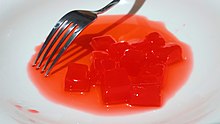| Komagataeibacter xylinus | |
|---|---|
| Scientific classification | |
| Domain: | Bacteria |
| Phylum: | Pseudomonadota |
| Class: | Alphaproteobacteria |
| Order: | Rhodospirillales |
| Family: | Acetobacteraceae |
| Genus: | Komagataeibacter |
| Species: | K. xylinus |
| Binomial name | |
| Komagataeibacter xylinus (Brown 1886) Yamada et al. 2013 | |
| Synonyms | |
| |
Komagataeibacter xylinus is a species of bacteria best known for its ability to produce cellulose, specifically bacterial cellulose.
History and taxonomy
The species was first described in 1886 by Adrian John Brown, who identified the bacteria while studying fermentation. Brown gave the species the name Bacterium xylinum. It has since been known by several other names, mainly Acetobacter xylinum and Gluconacetobacter xylinus. It was given its current name, with the establishment of the new genus Komagataeibacter, in 2012. It is the type species of the genus.
Genome and metabolism
K. xylinus is a member of the acetic acid bacteria, a group of Gram-negative aerobic bacteria that produce acetic acid during fermentation. K. xylinus is unusual among the group in also producing cellulose. Bacterial cellulose (also sometimes known as nanocellulose) is involved in the formation of biofilms. It is chemically identical to plant cellulose, but has distinct physical structure and properties.
The genome of a cellulose-deficient strain of K. xylinus was sequenced in 2011, and followed by the genomes of cellulose-producing strains in 2014 and 2018. The first cellulose-producing strain had a genome consisting of one chromosome 3.4 megabase pairs and five plasmids, of which one is a "megaplasmid" of about 330 kilobase pairs.
Key genes related to cellulose production occur in the four-gene operon bcsABCD, which codes for the four subunits of the cellulose synthase enzyme. All four genes are required for efficient cellulose production in vivo, although BcsA and BscB are sufficient in vitro. Several other genes in the K. xylinus genome are also involved in cellulose production and regulation, including a cellulase enzyme.
Uses and significance

K. xylinus was used for a long time as a model organism for the study of cellulose production in plants. It is also studied in its own right to explore bacterial biofilm production, cell-cell communication, and other topics of interest. Production of bacterial cellulose for industrial uses has been the subject of extensive research, but is limited by productivity and scalability.
K. xylinus is found to be the main microorganism in the culture of Kombucha.
K. xylinus is also traditionally used in the Philippines for the production of jelly-like nata de piña and nata de coco desserts, made from pineapple juice and coconut water, respectively. The former has been produced since the 18th century.
References
- ^ "Komagataeibacter". List of prokaryotic names with standing in nomenclature. Archived from the original on 20 March 2020. Retrieved 5 July 2018.
- ^ Römling, Ute; Galperin, Michael Y. (September 2015). "Bacterial cellulose biosynthesis: diversity of operons, subunits, products, and functions". Trends in Microbiology. 23 (9): 545–557. doi:10.1016/j.tim.2015.05.005. PMC 4676712. PMID 26077867.
- Yamada, Yuzo; Yukphan, Pattaraporn; Vu, Huong Thi Lan; Muramatsu, Yuki; Ochaikul, Duangjai; Nakagawa, Yasuyoshi (12 June 2011). "Subdivision of the genus Gluconacetobacter Yamada, Hoshino and Ishikawa 1998: the proposal of Komagatabacter gen. nov., for strains accommodated to the Gluconacetobacter xylinus group in the α-Proteobacteria". Annals of Microbiology. 62 (2): 849–859. doi:10.1007/s13213-011-0288-4. S2CID 256072970.
- Yamada, Yuzo; Yukphan, Pattaraporn; Lan Vu, Huong Thi; Muramatsu, Yuki; Ochaikul, Duangjai; Tanasupawat, Somboon; Nakagawa, Yasuyoshi (2012). "Description of Komagataeibacter gen. nov., with proposals of new combinations (Acetobacteraceae)". The Journal of General and Applied Microbiology. 58 (5): 397–404. doi:10.2323/jgam.58.397. PMID 23149685.
- ^ Klemm, Dieter; Kramer, Friederike; Moritz, Sebastian; Lindström, Tom; Ankerfors, Mikael; Gray, Derek; Dorris, Annie (6 June 2011). "Nanocelluloses: A New Family of Nature-Based Materials". Angewandte Chemie International Edition. 50 (24): 5438–5466. doi:10.1002/anie.201001273. PMID 21598362. S2CID 24555732.
- Ogino, H.; Azuma, Y.; Hosoyama, A.; Nakazawa, H.; Matsutani, M.; Hasegawa, A.; Otsuyama, K.-i.; Matsushita, K.; Fujita, N.; Shirai, M. (28 November 2011). "Complete Genome Sequence of NBRC 3288, a Unique Cellulose-Nonproducing Strain of Gluconacetobacter xylinus Isolated from Vinegar". Journal of Bacteriology. 193 (24): 6997–6998. doi:10.1128/JB.06158-11. PMC 3232855. PMID 22123756.
- ^ Kubiak, Katarzyna; Kurzawa, Marta; Jędrzejczak-Krzepkowska, Marzena; Ludwicka, Karolina; Krawczyk, Mariusz; Migdalski, Andrzej; Kacprzak, Magdalena M.; Loska, Damian; Krystynowicz, Alina; Bielecki, Stanisław (April 2014). "Complete genome sequence of Gluconacetobacter xylinus E25 strain—Valuable and effective producer of bacterial nanocellulose". Journal of Biotechnology. 176: 18–19. doi:10.1016/j.jbiotec.2014.02.006. PMID 24556328.
- ^ Liu, Miao; Liu, Lingpu; Jia, Shiru; Li, Siqi; Zou, Yang; Zhong, Cheng (19 April 2018). "Complete genome analysis of Gluconacetobacter xylinus CGMCC 2955 for elucidating bacterial cellulose biosynthesis and metabolic regulation". Scientific Reports. 8 (1): 6266. Bibcode:2018NatSR...8.6266L. doi:10.1038/s41598-018-24559-w. ISSN 2045-2322. PMC 5908849. PMID 29674724.
- Jankovic, I., & Stojanovic, M. (1994). Microbial and chemical composition, growth, therapeutical and antimicrobial characteristics of tea fungus. Mikrobiologija (Yugoslavia).
- Sutanto, Agus Tri (2012). "Pineapple Liquid Waste as Nata De Pina Raw Material". Makara, Teknologi. 16 (1): 63–67. doi:10.7454/mst.v16i1.1286. S2CID 56381771.
- Vergara, Benito S.; Idowu, Panna Melizah H.; Sumangil, Julia H. (1999). Nata de Coco: A Filipino Delicacy (PDF). National Academy of Sciences and Technology, Philippines. ISBN 9718538615. Archived (PDF) from the original on 2021-06-28. Retrieved 2021-03-07.
| Taxon identifiers | |
|---|---|
| Komagataeibacter xylinus | |